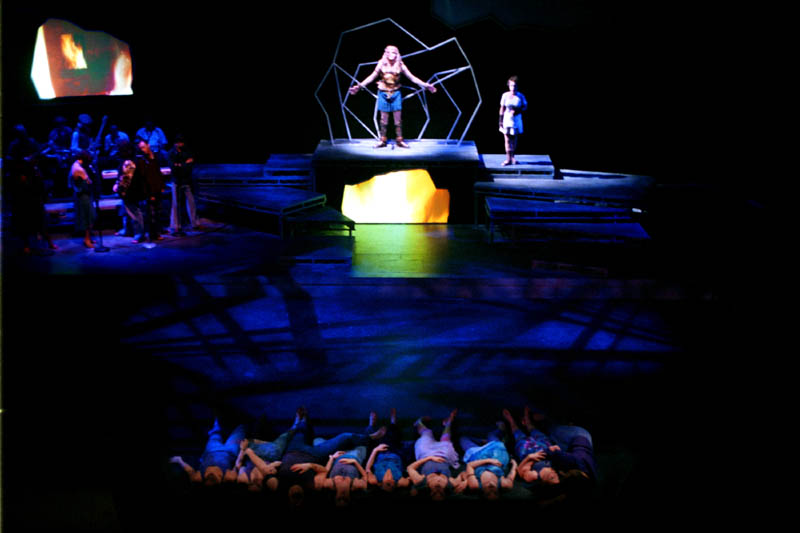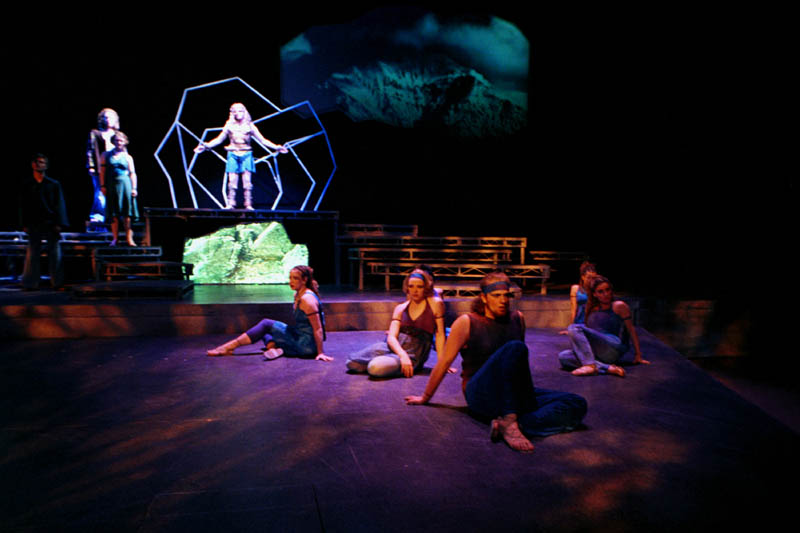The
University of Minnesota Duluth
Department of Theatre
presents
Prometheus
Bound
by Aeschylus
New Translation by Jon Berry
Directed by William Payne
Choreography by Ann Aiko Bergeron
Scenic Design by Mark Engler
Video Design by William Payne & Jennifer Gordon
Costume Design by Sarah Bahr
Lighting Design by Mark Harvey
February 10-19, 2005
Marshall Performing Arts Center
All photos by Mark Harvey unless otherwise noted.
Lighting Design Approach
The director wanted to bring this play to a contemporary audience by including a variety of modern elements. He chose to include a six piece rock band, a group of jazz dancers, and video imagery in an attempt to entice the audience into pondering the substantial risk Prometheus took when he gave humankind fire. At various points during the play, the band performed songs by The Temptations and Stevie Wonder. Dancers visually interpreted the words to these protest songs from the late 60's and early 70's.
The scenic design consisted of two distinct areas. Upstage was a series of platforms leading to a skeletal rock up center. The thrust portion of the stage was used for dance.
Thematically, there was a strong connection between Prometheus' choice to protect humankind from extinction and a period within most of the audience's memory when it could be argued the human race was not living up to Prometheus' optimism. Interspersing rock music and dance throughout the play broke the script into more digestible segments, and the words to the songs indicated how we continue to struggle with the same issues the Greeks attempted to address more than 4,000 years ago.
Throughout the production meeting phase of the project, I pondered the best way to visually connect the two different performance spaces, When I first watched rehearsal, I immediately knew the strategy I wanted to use to light the play portion of the space. The vast majority of the blocking had characters looking up to Prometheus, chained to a rock, as they spoke. Prometheus and his rock were clearly the focal point of the space. My idea was to have the key light for all acting positions on the platforms to look as if it were coming from the rock up center. Fill light for these areas was to be dark blues and purples, chosen specifically to accent colors in the costumes.
Questions remained as to how to best treat the dance portion of the performance space. My first inclination was to use the same colors as the play portion of the space, but the saturation proved to be too dark to offer enough variation for the seven different songs that were performed. The solution was the use of texture. Lighter gel colors with more texture in the light made it possible to create a wider variety of looks, but still maintain the sense of foreboding the play requires. During tech week, three new sets of gobo patterns were added to the three originally planned to maintain the tragic feel of the play while shifting the color into ranges more adaptable for dance. We retained the saturated look for numbers such as "Ball of Confusion", but used less saturated colors combined with a variety of gobo patterns in numbers such as "Superstition".
Ball of Confusion
Superstition
It was also important for the lighting to highlight choreography that used the three edges of the thrust stage. Light along each edge was controlled separately in order to tailor the lighting specifically to the choreography.
 |
| photo by Brett Groehler |
Another important image we wanted to capture was when Prometheus first mentions the word "fire". Fire is the symbol the play uses for all that makes humankind sentient. This moment in the play was enhanced with a series of fire-like gobos that were programmed into a random flickering pattern.
 |
| Photo by Brett Groehler |
Video projections were also incorporated into the production. Videos ranged from black and white to color images and it was important to keep colors in the lighting dark enough to frame the images for the audience.
There were a few times when major characters used a presentational approach to tell their story. In these situations, a color corrected follow spot, lightly frosted to remove the sharp-edged circle, was used for key light.
Oceanus enters "upon a winged steed". The chorus provided the understructure to create the illusion of Oceanus' flying entrance. Uplighting in blue tones, also textured with water-like patterns, helped complete the visual imagery.
Prometheus Bound
Review
Printed Saturday, February 12, 2005
UMD Updates Prometheus Without Keeping Audience Eternally Chained
to Seats
by PAUL BRISSETT
for THE DULUTH NEWS TRIBUNE
Take your title character and shackle him hands and feet to an
iron-frame center stage for the duration of the play while he tells his story.
This is theater? All talk, no action?
It was enough to entrance the ancient Greeks because it set dramatically before
them their tradition of how mankind came to be. But modern audiences -- although
the story includes striking parallels to the Judeo Christian version of creation
-- have been conditioned by film, television and cyber-communication to expect
more. In UMD Theatre's production of Prometheus Bound that opened Thursday,
director Bill Payne enlivens and embroiders the basic story with visual bling,
modern music and dance. The result fully satisfies the modern appetite for sensation.
The basic story is that the god Prometheus has angered Zeus by delivering fire
to mortals and teaching them to use it. As Zeus viewed mankind as hopeless and
indeed intended to replace it with a new and improved race, he regards Prometheus'
actions as treason, and orders him chained to a craggy mountaintop forever.
The characters include Prometheus, played by Andy Frye in this production; the
traditional Greek chorus, replaced here by an on-stage rock band; six singers
and eight dancers; the god Oceanus (Kecia Rehkamp); the mortal Io (Kate Blaeser);
and the divine messenger Hermes (Jen Reinier). Though the chorus, Oceanus and
Hermes urge Prometheus to repent, apologize and vow obedience to Zeus in order
to be freed, he scornfully refuses, saying he would prefer eternity chained
to the rock to groveling before Zeus. He also discloses his prophetic visions,
including the eventual downfall of Zeus. Further angered by Prometheus' defiance,
Zeus sends a thunderbolt to shatter the crag, plunging Prometheus into the abyss.
Over its roughly 2,500 years of existence, Prometheus Bound has been
interpreted in countless ways, two of the most common being as a caution against
government and other institutions and as an examination of man's inhumanity
to man. Director Payne sees it as posing the question of how man uses the gift
of "fire" -- his humanity. Payne works with a new translation from
the original Greek by UMD associate professor Jon Berry that gives the text
an admirable accessibility. It's especially evident in Prometheus' prophecy
for Io and her descendants, which seem to foretell events millennia in the future,
such as wars, African famine and the North American slave trade.
The ancient story is staged on a high-tech set designed by Mark Engler, dominated
by three high-resolution displays for videos designed by Payne and Jennifer
Gordon and lit by Mark Harvey, whose impressive effects include making the iron
framework that represents the central crag seem to glow in the dark. Sarah Bahr's
costume and makeup designs also reflect the broad and timeless tone, from one
character's elegant, modern suit to another's metallic, mechanical armor, topped
with an oversized, cartoonish plume.
The constraints of script, style (long and often slightly overripe speeches)
and tradition (which calls for elaborate masks for the characters) leave little
latitude for actors, but within them Payne's cast acquits itself well. Blaeser's
recounting of how her character, Io, came to its sorry state is particularly
moving. Musical director Dan Ristrom, his six-piece band and the chorus, ably
led by Hannah Cavins-Wolford and Ben Elledge, offer thoughtful and deft interpretations
of songs by the Temptations and Stevie Wonder. Choreographer Ann Aiko Bergeron's
dancers emphasize and punctuate the text, not only leaping and whirling, but
also at times more literally reflecting what's being said, as when they cower
and crawl during Prometheus' prophecy for Io.
The play is short: about 90 minutes without intermission. That's another concession
to modernity. The original production probably lasted several days.